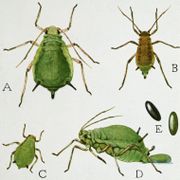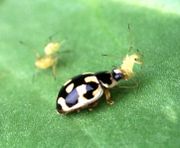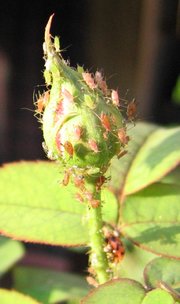Aphid
2007 Schools Wikipedia Selection. Related subjects: Insects, Reptiles and Fish
- "Aphid" is also the NATO reporting name for the Soviet/Russian Molniya R-60 air-to-air missile.
| iAphids | ||||||||||||
|---|---|---|---|---|---|---|---|---|---|---|---|---|
 |
||||||||||||
| Scientific classification | ||||||||||||
|
||||||||||||
|
|
||||||||||||
|
There are 10 families:
|
Aphids, also known as greenfly, blackfly or plant lice, are minute plant-feeding insects in the superfamily Aphidoidea in the homopterous division of the order Hemiptera. Recent classification within the Hemiptera has changed the old term 'Homoptera' to two suborders: Sternorryncha (aphids, whiteflies, scales, psyllids...) and Auchenorryncha (cicadas, leafhoppers, treehoppers, planthoppers...) with the suborder: Heteroptera containing a large group of insects known as the 'true-bugs'; gnat bugs, pond skaters, shore bugs, toad bugs, water boatmen, backswimmers, etc.
About 4,000 species of aphids are known, classified in 10 families; of these, around 250 species are serious pests for agriculture and forestry as well as an annoyance for gardeners. They vary in size from 1-10 mm long.
Important natural enemies include the predatory ladybugs ( Coleoptera: Coccinellidae), hoverfly larvae ( Diptera: Syrphidae), and lacewings ( Neuroptera: Chrysopidae), and entomopathogenic fungi like Lecanicillium lecanii and the Entomophthorales.
Aphids are distributed world-wide, but they are most common in temperate zones. It is possible for aphids to migrate great distances (mainly through passive dispersal riding on winds) depending on the weather patterns; for example, the lettuce aphid spreading from New Zealand to Tasmania. They have also been spread by human transportation of infested plant materials.
Anatomy
The most typical organ of aphids is their piercing-sucking mouthparts called stylets. They have soft bodies, long, thin legs, two-jointed, two-clawed tarsi, and usually a pair of abdominal tubes through which a waxy secretion is exuded. These tubes were formerly supposed to secrete the sweet substance known as " honeydew" so much sought after by ants; but this is now known to come from the alimentary canal. Both winged and wingless forms of both sexes occur; the wings when present are two pairs, lacy, transparent and only have one prominent longitudinal vein. Aphids also have a proboscis originating between and behind the forelegs. Aphids' antennae are composed of two thick basal segments and a flagellum with as many as four segments. The last of these four segments is divided into a proximal part and a thinner distal part (called process terminalis).
Aphids have two compound eyes and two ocular tubercles made up of three lenses, each of which is located behind and above the compound eyes. They have two tarsal segments. The fifth abdominal segment bears a pair of tubes on the dorsal surface named siphunculi (cornicles), which are upright and point backward. A cauda is usually present below and between them on the last abdominal segment.
Diet
Many, but far from all, aphids are monophagous (i.e. feeding only on 1 species of plant). Others, like Myzus persicae feed on hundreds of plant species across many families.
Similarly to related families, aphids passively feed on sap of phloem vessels in plants. This sap being kept under high pressure, once a phloem vessel is punctured, it is forced into the food canal. Aphids actively 'drink' (suck) from xylem vessels when thirsty. As they feed, aphids often transmit plant viruses to their food plants. These viruses can sometimes kill the plants.
Some species of ants "farm" aphids, protecting them on the plant they eat, and eating the honeydew that the aphids secrete; this is a mutualistic relationship. Aphid honeydew is rich in carbohydrates (like melezitose), of which the aphids ingest an excess, being phloem-feeders. Many aphids are host to endosymbiont bacteria, Buchnera, which live in specialized cells called Bacteriocytes inside the aphid. These bacteria synthesizes some essential amino acids that are absent in the phloem that the aphids eat.
Reproduction
Apart from their importance from the economic standpoint, aphids are chiefly remarkable for the phenomena connected with the propagation of the species. For part or all of their life, most aphids are often found to be parthenogenetic. Aphids have been known to have what is called telescoping generations. With telescoping generations the female aphid will have a daughter within her who is already parthenogenetically producing its own daughter at the same time. This leads to the bizarre situation where the diet of a female aphid can have inter-generational effects on the body size and birth rate of aphids. In other words, what the aphid eats can directly change the size and fertility of the aphid's daughters and grand-daughters (Nevo and Coll 2001, Jahn et al. 2005).
At different times of the year, they can be viviparous or oviparous. During spring and summer, aphids are often parthenogenetic and viviparous and then give birth sexually during autumn. Therefore aphids are said to undergo cyclical parthenogenesis or to have a holocyclical life circle.
Male and female aphids mate in autumn. Sexual females, but also asexual ones, have two sex chromosomes while sexual males only have one.
The following brief summary of what takes place in the plant-louse of the rose ( Aphis rosae), may be regarded as typical of the family, though exceptions occur in other species: Eggs produced in the autumn by fertilized females remain on the plant through the winter and hatching in the spring give rise to female individuals which may be winged or wingless. From these, females are born parthenogenetically: that is to say, without the intervention of males, and by a process that has been compared to internal budding, large numbers of young resembling their parents in every respect except size are produced, which themselves reproduce their kind in the same way. This process continues throughout the summer, generation after generation being produced until the number of descendants from a single individual of the spring-hatched brood may amount to many thousands. In the autumn winged males appear; union between the sexes takes place and the females lay the fertilized eggs which are destined to carry the species through the cold months of winter. If, however, the food-plant is grown in a glasshouse or greenhouse where protection against cold is afforded, the aphids may go on reproducing agamogenetically (asexually) without cessation for many years. Likewise, in warm and tropical areas or during the growing season, aphids reproduce asexually without interruption. Since the young can become adults and reproduce within a few days, this process leads to the build-up of very large populations responsible for severe damage to crops and important economic losses; such populations often require pest control.
Not the least interesting features connected with this strange life-history are the facts that the young may be born by the oviparous or viviparous methods and either gamogenetically or agamogenetically, and may develop into winged forms or remain wingless, and that the males only appear in any number at the close of the season. Although the factors which determine these phenomena are not clearly understood, it is believed that the appearance of the males is connected with the increasing cold of autumn and the growing scarcity of food, and that the birth of winged females is similarly associated with decrease in the quantity or vitiation of the quality of the nourishment imbibed. Sometimes the winged females migrate from the plant they were born on to start fresh colonies on others often of quite a different kind (host plant alternancy). Thus the apple aphid (Aphis mali) after producing many generations of apterous females on its typical food-plant gives rise to winged forms which fly away and settle upon grass or corn-stalks.
Another widespread aphid in the Phylloxeridae family is Daktulosphairia vitifoliae (still frequently called by its former name Phylloxera vitifoliae), the famous Phylloxera which causes enormous loss by attacking the leaves and roots of grape vines. Its life-history is similar to that of Aphis rosae described above. In the autumn a single fertile egg is laid by apterous females in a crevice of the bark of the vine where it is protected during the winter. From this egg in the spring emerges an apterous female who makes a gall in the new leaf and lays therein a large number of eggs. Some of the apterous young that are hatched from these form fresh galls and continue to multiply in the leaves, others descend to the root of the plant, becoming what are known as root-forms. These, like the parent form of spring, reproduce parthenogenetically, giving rise to generation after generation of egg-laying individuals. In the course of the summer, from some of these eggs are hatched females which acquire wings and lay eggs from which wingless males and females are born. From the union of the sexes comes the fertile egg from which the parent form of spring is hatched.
Some species of cabbage aphids (like Brevicoryne brassicae) reproduce rapidly during the summer. They are all females, and can produce up to 41 generations of offspring. If no aphids had died during the summer, there would be more than one and a half billion billion billion aphids (1.5 x 1027) by the end of the season.
Evolution
Aphids probably first appeared 280 million years ago, in the Carboniferous period. They probably fed on non-flowering plants like Cordaitales or Cycadophyta. The oldest known aphid fossil is one of the species Triassoaphis cubitus from the Triassic. There were relatively few species of aphids at that time, and the number of species only considerably increased since the appearance of angiosperms 160 millions of years ago. This is due to the fact that angiosperms provide an occasion for aphids to become specialized.
Aphids have not always looked like they do nowadays. Organs like the cauda or the siphunculi were not evolved until the Cretaceous.












